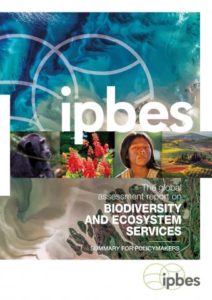With the year coming to an end we wanted to round up a few of the biggest (or more accurately – our favourite) conservation news stories of 2019.
4. Missed Targets for 2020
For much of the last decade 2020 has been seen as a deadline by which meaningful change will need to occur in order to preserve the world’s biodiversity. However, throughout this year it has become increasingly clear that most of these targets will not be met.
The UK is set to meet only 4 out of its 19 applicable Aichi biodiversity targets (set out in 2010 by the Convention on Biological Diversity). A report published this year highlighted that 52% of the UK public report no awareness of the threats to biodiversity – representing a failure of the public awareness target. Similarly, targets concerning controlling invasive species, reducing pollution and species declines have not been met.
At a global level the situation is not much different. Aichi target 11, for example, aims for 17% of Earth’s terrestrial surface and 10% of its marine surface to be designated as protected areas. As of this year, these targets were missed by 2% and 2.2% respectively. However at a finer scale the situation is worse: out of 823 terrestrial ecoregions, 102 have under 2% coverage of protected areas.
However, hope for next year comes in the form of the next international conference in Kunming, China. Here new targets, measured more qualitatively and more strictly enforced, could help safeguard biodiversity for the coming decade.
To learn more about biodiversity conventions, click here.
3. A Year Of Fire
Fire was one of the conservation topics that got the most public attention this year. Currently, Australia is hitting the headlines as it suffers from extremely severe bushfires. These fires come during times of record-breaking temperatures for the country and the increase in fire severity has been linked to climate change.
Earlier in the year, fires in the Amazon were a top trend on many social media platforms. They came in the form of a 77% increase in the number of fires in the Brazilian Amazon in August compared to last year, as reported by Brazil’s National Agency for Space Research. Much of this increase has been attributed to higher levels of deforestation due to president Jair Bolsonaro’s anti-environmental policies. Although, similar increases were seen in neighbouring countries, such as Bolivia, Paraguay and Peru, as well as further afield.
These fires also came as an insight into the interactions between social media and conservation issues. The fires in the Amazon trended top on twitter and lots of public awareness was raised on the platform. However, this attention was not without its issues. Whilst the fires in the Amazon received lots of attention, similar fires, in Indonesia for example, got next to none. Another problem was the spread of false information about the fires: for example, this tweet, by French President Emmanuel Macron, was criticised for inaccurately showing an image of a different fire from 16 years ago.
Our house is burning. Literally. The Amazon rain forest – the lungs which produces 20% of our planet’s oxygen – is on fire. It is an international crisis. Members of the G7 Summit, let’s discuss this emergency first order in two days! #ActForTheAmazon pic.twitter.com/dogOJj9big
— Emmanuel Macron (@EmmanuelMacron) August 22, 2019
Another issue with the social media attention was its short-lived nature. Despite trending for just a few weeks, the fires were still burning months later. A study this year suggested that we’re spending increasingly smaller amounts of time focusing on each news story or trend that we encounter. Given that most conservation issues involve sustained long-term pressures, it raises questions about how conservation scientists should use social media to reach out in ways that avoid “fake news” and being so easily forgotten.
To learn more about fire as a conservation issue click here and for more on social media and conservation, click here
2. IPBES Report
 This year saw the publication of The Global Assessment Report on Biodiversity and Ecosystem Services by IPBES (Intergovernmental Science-Policy Platform on Biodiversity and Ecosystem Services).
This year saw the publication of The Global Assessment Report on Biodiversity and Ecosystem Services by IPBES (Intergovernmental Science-Policy Platform on Biodiversity and Ecosystem Services).
This report is a global assessment of the state of biodiversity – the first since the Millennium Ecosystem Assessment was published in 2005. It was compiled by 150 authors and incorporated data from 15,000 sources.
Key findings included:
• Average decreases in species abundances of 20%,
• 75% of land environments being significantly altered by human activity,
• A 23% reduction in the productivity of the global land surface due to human activity,
• $577 billion dollars’ worth of annual global crops are at risk due to loss of pollinators.
They concluded that ~1,000,000 species of plants and animals are threatened with extinction as a result of human activity.
The report also addressed policy and concluded that only radical transformative changes will succeed in stopping negative trends in nature by 2050. They suggest possible future actions and pathways and will inform decision making in the 2020s and beyond. As well as this, they broke new ground on considering issues relevant to local and indigenous communities, who have too often been ignored by conservation scientists.
The report’s chair Professor Sandra Díaz – recently named by Nature as one of the 10 most influential people of the year – said: “Biodiversity and nature’s contributions to people are our common heritage and humanity’s most important life-supporting ‘safety net’. But our safety net is stretched almost to breaking point.” Hopefully this report can help in efforts to protect that safety net.
1. Notable Conservation Success Stories
Despite all the doom-and-gloom, there have been many examples of positive stories this year which we think it’s important to highlight.
Many species were rediscovered this year. Scientists rediscovered the silver-backed chevrotain – a species of small ungulate – from camera trap images in Vietnam. Other rediscovered species include the pale-faced bat, Wallace’s giant bee, false tree coral snake and Fernandina giant tortoise. Many species also improved their conservation status: the Guam Rail recently hit the news for becoming only the 2nd bird species to ever recover from being extinct in the wild and the Echo Parakeet this year moved up to Vulnerable on the IUCN red list – where in 2007 it had been Critically Endangered.
Another victory this year came when the Waorani community won a legal battle against the Ecuadorian government, who had unlawfully planned to auction the community’s land in the Amazon for oil exploration.
 This year also saw increasing awareness of conservation issues, with climate and extinction based strikes and protests becoming commonplace. Hopefully this can lead to policy changes in the coming decade, with 54% of people in the UK now saying that climate change will affect how they vote.
This year also saw increasing awareness of conservation issues, with climate and extinction based strikes and protests becoming commonplace. Hopefully this can lead to policy changes in the coming decade, with 54% of people in the UK now saying that climate change will affect how they vote.
Find out more about the importance of conservation optimism here.
Here’s hoping lots of conservation progress can be made in the upcoming decade. Happy New Year from CUWCS 🙂

Be the first to reply